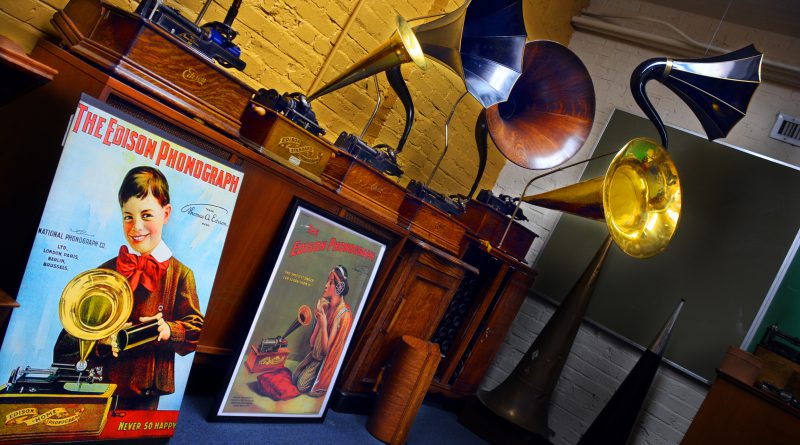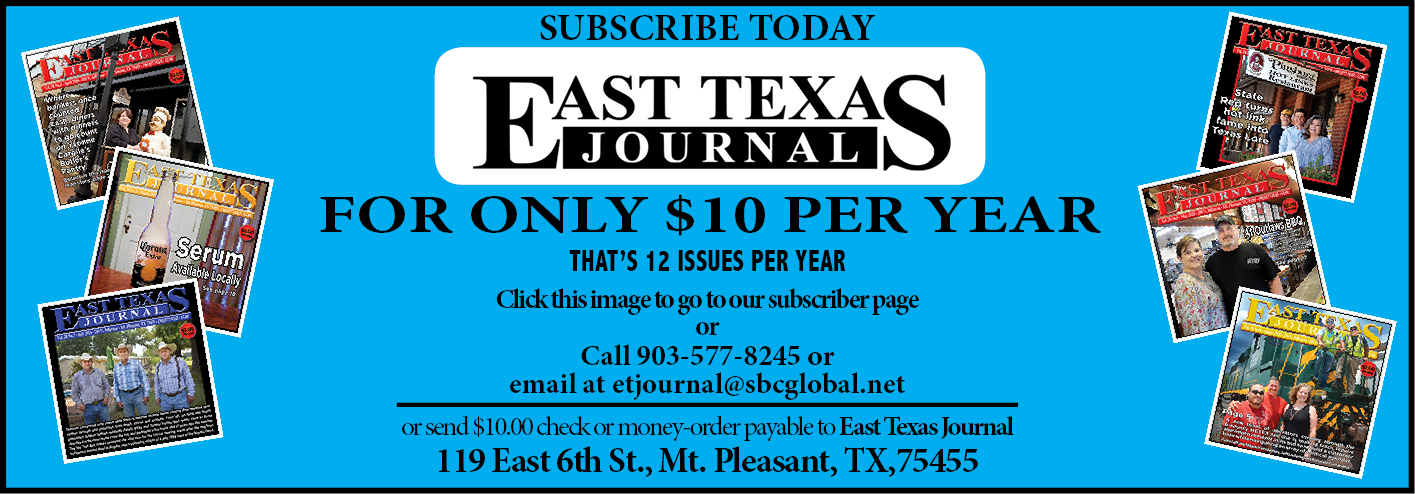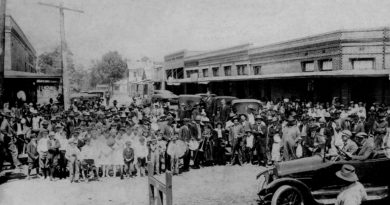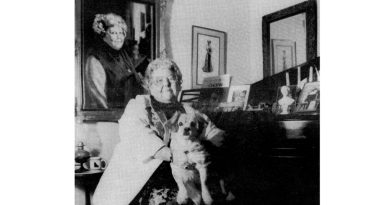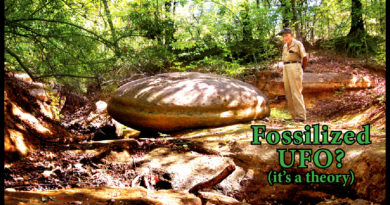Edison Phonograph Museum

The private phonograph museum sharing space with a new western wear store in the old library basement is turning into an avenue co-founders Dustin Ellis and David Hoover have increasing reason to see as an international draw to Main Street.
Imagine a gun show, but for phonographs.
“The Orlando Phonograph Show started as a swap meet in a motel parking lot,” said Dustin, a Mt. Pleasant police officer, a collector moonlighting as curator of the curator of the Historic Downtown Mt. Pleasant Edison Phonograph Museum. “Twenty vendors at this year’s show drew collectors from England, Japan and Korea.”
Reason suggests the 60-plus exhibits in the Mt. Pleasant museum provide a better springboard than the parking lot that launched a show now drawing an annual crowd pushing a thousand in Orlando.
It’s a thought lending direction to the newly formed Texas Antique Phonograph Society (TAPS,) the brainchild of Pittsburg businessman David Hoover, who was already envisioning a museum in the old library when he opened a Mt. Pleasant location of Hoover’s Jewelry here less than two years ago.
“The history of the phonograph and early recordings is one that includes science, politics and economic struggles during the late 19th and early 20th centuries,” said David, who’s been collecting, trading and rebuilding vintage phonographs for 30 years, longer than the museum’s 25-year-old co-founding partner has been alive.
“He didn’t have his driver’s license the first time his grandmother drove him to Pittsburg because he knew I rebuilt phonographs,” David said. “As young as he was when he began restoring phonographs and learning a story that spread overseas to people building on Edison’s work, he grew up with a good perspective on the impact of an invention.”
The museum’s collection includes recording equipment of the same make used in Teddy Roosevelt’s living room recordings of campaign speeches sent out to be played across the land.
They’ve got an original recording Roosevelt made for his 1912 Bull Moose third party run for the White House.
Beyond the grand vision of an event luring collectors, David hopes to connect the museum to public school history class field trips. They’re set up to record a school choir with century old technology developed by one of the most innovative minds spanning the latter 19th and early 20th centuries.
The story of the inventor of the phonograph lends itself to seeing historic preservation as more than a local, state, national or even international thing.
“It’s a universal thing that’s more easier to grasp as you become more familiar with the depth of Edison’s story,” David said. “He was a plunger. He didn’t care as much for money as for what he could do with it. At the height of his work he had 8,000 employees including the chemists, engineers, biologists – the best scientists money could buy. They worked in everything from electronics to construction.
Jean-Paul Agnard of the Musee Edison de Phonographe, a Frenchman at the Florida show, sold Dustin a “speaking tube” for an Edison Class M phonograph of the sort first sold to a German Duke in the 1880’s.
“All I need to restore a machine that’s now going for $40,000 is all the rest of the parts,” he said.
He had more in common with the ex-New Jersey cop who found the new Edison museum in Texas on line.
“Charlie Hummel thinks like we think,” said Dustin, speaking as a museum docent. “During the years that there wasn’t much interest in this stuff, what wasn’t thrown out drifted into the hands of a mostly closed society of collectors.
“Mr. Hummel got interested as a cop on patrol in the 70’s,” he said. “When Edison’s labs were derelict buildings being vandalized and looted, he salvaged the artifacts that were returned when Orange Lab was restored as a National Historic Site.
Meanwhile, the policeman’s interest in Edison’s work turned him into a collector, a hobby that became an avocation that became a retirement career.
“You can catch him on the Discovery Channel,” Dustin said. “You can tune him in on a NetFlix broadcast of ‘Oddities.’”
Giant pages of a scrapbook of newsclippings compiled by Edison validate the New Jersey collector’s claim that the idea he shares with new friends in Texas is that they’ve got a story that needs to be shared rather than locked away in private collections.
“The only reason I could afford the scrapbook is that he sold it to me for significantly less than its value,” Dustin said. Edison reproduced news clippings pertaining to demonstrations of his concert phonographs in opera houses of the era.
In the dawn of the recording era, Edison hired performers to travel with his phonographs.
Before Texas-born Vernon Dalhart’s “Wreck of the Old 97” became the first million selling record, he worked for Edison demonstrating phonographs.
“The show opened with what was familiar, a live performance,” Dustin said. “Then they’d bring down the lights and bring up the music and when the lights came back up the performer would be gone and the audience found itself hearing music played by a phonograph.”
It was an act on par with a magic show, an electrical marvel. Edison produced something fewer than 20 of the newsclipping scrapbooks for his marketing division.
The clippings in the scrapbook he bought aren’t original.
“Besides perfecting the light bulb and developing the phonograph, Edison’s work included development of the first copy machines,” Dustin said. “The ‘rotogravure’ process used to reproduce clippings for the Edison scrapbooks was a sort of collision between photography and what evolved into the mimeograph machine.
“It’s as much the technology he used to make the scrapbook as their content that gives it its historic value,” he said.
Beyond the museum’s reach into the universe of phonograph enthusiasts, in addition to its potential as a classroom field trip destination, the coincidental timing of its opening comes at a time that city hall is churning up life in the business district, pumping money into downtown events.
This year’s budget includes $30,000 for development of a Main Street plan coupling historic preservation to economic development spanning from support for traditional retail and tourism.

